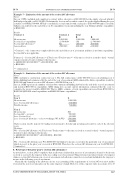Page 673 - SAIT Compendium 2016 Volume2
P. 673
IN 78 Income Tax acT: InTeRPReTaTIon noTes IN 78
Example 7 – Limitation of the amount of the section 24C allowance
Facts:
In year 1 NFI concluded and completed a contract with a sales price of R2 000 000 for the supply of goods which it had budgeted would cost R1 500 000. Unfortunately, for reasons beyond its control, the goods supplied during the year actually cost NFI R2 500 000. NFI also concluded a second contract with a sales price of R1 000 000 and received the full price in cash before the end of the year. No expenditure was incurred during the year. Estimated future expenditure is R600 000.
Result:
Contract 1
Gross income
Section 11(a) expenditure Section 24C allowance* Assessed loss
Contract 2 Total RRR
2 000 000 (2 500 000) Nil
(500 000)
1 000 000 Nil
(600 000) 400 000
3 000 000 (2 500 000) (600 000) (100 000)
* Contract 1 – the contract was completed before the end of the year of assessment and there is no future expenditure. Section 24C is not applicable.
Contract 2 – Section 24C allowance = [(Total costs / Total revenue)** × Income received or accrued to date] – Actual expenses incurred to date relating to that income
= [(R600 000 / R1 000 000)** × R1 000 000] – R0
= R600 000
** = limited to 1
Example 8 – Limitation of the amount of the section 24C allowance
Facts:
GHI concluded a construction contract in year 1. The full contract price of R1 000 000 was received during year 1 but no building had commenced by the end of the year of assessment. GHI estimated the future expenditure would be R500 000 and claimed a section 24C allowance of R500 000 in year 1.
In year 2 GHI experienced a number of delays but commenced building just before the end of the year of assessment and incurred R60 000 in expenditure. GHI, taking into account current information, estimated that the costs to complete the project would be R600 000. That is, GHI’s estimate of total expenditure increased from R500 000 to R660 000 (R60 000 actual expenditure and R600 000 future expenditure).
Result:
Year 1
Gross income
Less: Section 24C allowance Taxable income
Year 2
Gross income
Section 24C – reversal
Less: Section 11(a)
Less: Section 24 allowance – refer to workings (W1 & W2)
R
1 000 000
(500 000) 500 000
Nil
500 000
(60 000) (500 000) (60 000)
Under section 22(2A) and 22(3A) trading stock deemed to be held and not disposed is nil for each of the relevant years.
Workings:
W1 – Section 24C allowance = [(Total costs / Total revenue)* × Income received or accrued to date] – Actual expenses incurred to date relating to that income
= [(R660 000 / R1 000 000)* × R1 000 000] – R60 000 = R600 000.
W2 – Section 24C allowance per W1 (R600 000) but limited to income received in the particular year of assessment which in year 2 is the prior year’s reversal of R500 000. Therefore, the section 24C allowance in year 2 is R500 000. * limited to 1
6. Reversal of the prior year’s section 24C allowance
As noted above, section 24C(3) stipulates that an allowance deducted in any year of assessment is deemed to be income received or accrued to the taxpayer in the succeeding year of assessment. This provision is not discretionary; if a taxpayer claims a section 24C allowance in a year of assessment such allowance must be reversed and included in the taxpayer’s income in the following year of assessment.
Generally, the claiming of the allowance in one year (assuming all the requirements of section 24C were met) and the reversal in the next year takes place in the same taxpayer’s hands. However, if the corporate rules in sections 41 to 47
saIT comPendIum oF Tax LegIsLaTIon VoLume 2 665


